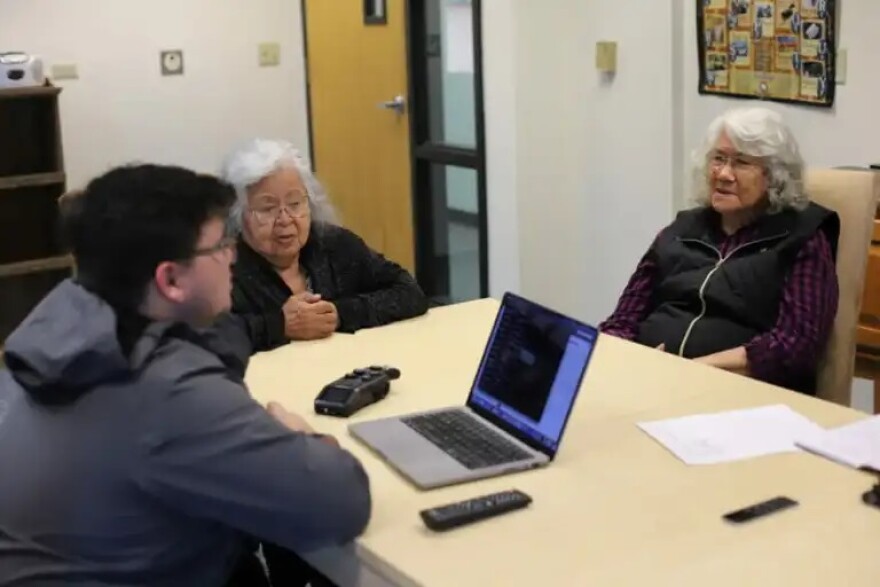The Sun’aq Tribe of Kodiak in collaboration with the Alutiiq Museum have released a textbook to help revitalize an endangered Alaska Native language.
The Alutiiq language also known as Sugpiaq is broken up into two main dialects, the Koniag Alutiiq spoken in Kodiak as well as the upper Alaska Peninsula, and the Chugach Alutiiq, which is spoken on the Kenai Peninsula and Prince William Sound.
A new Alutiiq Language textbook, released to the public last month on Dec. 12, focuses on the Koniag dialect, although it’s open to anyone who wants to learn Alutiiq.
Alutiiq Language and Living Culture Manager at the Alutiiq Museum, Dehrich Chya, is one of the co-authors. He says many Alutiiq speakers were consulted to create this textbook.
“Whenever we’re doing any language, producing any language materials, we work as much as we can with language speakers who live here in Kodiak. Over the past few years, that has gotten harder and harder as speakers have passed on,” Chya explained.
In 2007, data from the Alaska Native Language Center listed the population of Sugpiaq/Alutiiq people at 3,500 and only half a percent of the population as fluent speakers. This metric is complicated and unreliable however due to how speaker fluency was determined and who qualified as a member of the Sugpiaq/Alutiiq people at the time.
According to the Sun’aq Tribe, fewer than 20 first-language Alutiiq speakers remain today.
Of the roughly two-dozen Elders who are fluent in the Kodiak Island dialect, the Alutiiq Museum worked with four of them to make sure pronunciations, grammar and other aspects of the textbook were accurate. Although not all of them are still alive today to see it published. According to Chya, “one of them unfortunately passed away, and another fluent speaker moved to another community.”
Chya started his language journey with nearly no knowledge of Alutiiq, having rarely heard it spoken when he was growing up. Now he is an advanced speaker who still considers himself a language learner. He says this textbook, in conjunction with all the other online language resources, can help revitalize the endangered Alaska Native language. But there are still challenges that exist for a beginner to become fluent in Alutiiq.
“I think the hardest part of learning the language is finding time to use it with somebody,” he said. “Because language learning for a lot of people is quite a personal journey and not everybody has the opportunity to have other people around them who are also learning at the same time or at the same rate.”
With Elders and fluent Alutiiq speakers dying off, there is a need for more speaker-teachers to help the next generation achieve proficiency in their second language. In the hopes of addressing this, the Sun’aq Tribe started an Alutiiq Master-Apprentice Program over two years ago to train at least five fluent speaker-teachers.
That’s where Peggy Azuyak comes in. She’s teaching Alutiiq language classes to young adults, and this is the first semester she has been able to teach from the new textbook in her Alutiiq 102 class at Kodiak College, under the University of Alaska Anchorage. She is also a full-time Secondary and Alutiiq Language teacher at the Old Harbor School.
Azuyak says the new textbook is easier to follow compared to the previous one they used that dated back to the 1970s – Dr. Jeff Leer’s dictionary and grammar books, which weren’t published until the 1990s. The new Alutiiq Language textbook features 15 chapters, including sections on numbers and math, and is targeted towards high school and college age students.
“Many of the students also, through their tribal organizations or corporations, do teach the language,” Azuyak said. “Several high school students have been interested in going through either the Kodiak High School or College courses and are involved with teaching the language in their home communities.”
The Sun’aq tribe has plans to distribute hard copies to all of the schools in the communities on Kodiak Island after they are printed, sometime later next month. Anyone who wants to learn to speak Alutiiq can access the Alutiiq Language textbook online.
Chya acknowledged and thanked everyone who was involved in putting the textbook together, including:
Peggy Arnangcuk Azuyak, M.A.,
Michael Nanit’sqaq Bach, M.A.,
Candace Cutmen Branson, M.A.,
Alisha Agisaq Drabek, Ph.D.
and Tonya Iwa’ista Heitman, J.D.


